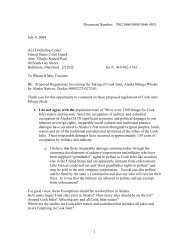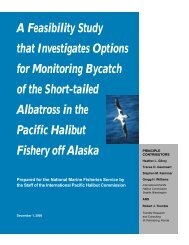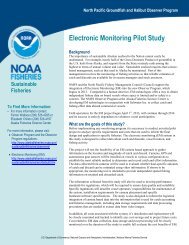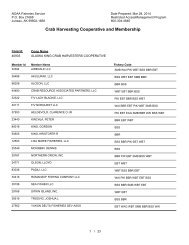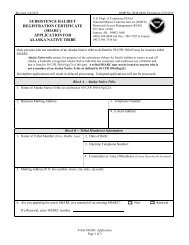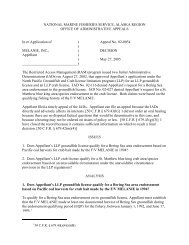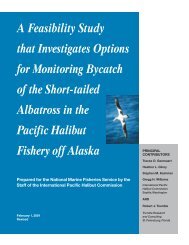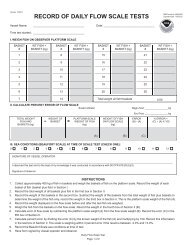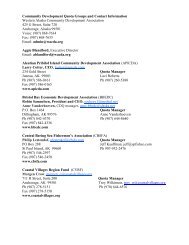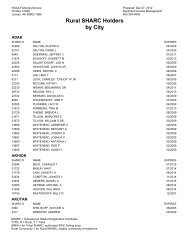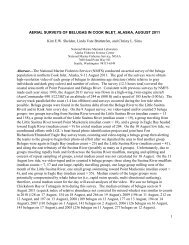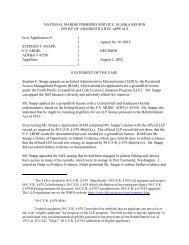Petition to List Lynn Canal Pacific Herring under the Endangered ...
Petition to List Lynn Canal Pacific Herring under the Endangered ...
Petition to List Lynn Canal Pacific Herring under the Endangered ...
You also want an ePaper? Increase the reach of your titles
YUMPU automatically turns print PDFs into web optimized ePapers that Google loves.
(USFWS-NMFS 1980: 7). Carlson showed that <strong>Lynn</strong> <strong>Canal</strong> <strong>Herring</strong> do not intermingle<br />
with o<strong>the</strong>r herring populations, unlike populations in Sitka and Craig.<br />
In <strong>the</strong> early 1930’s <strong>the</strong> <strong>Pacific</strong> herring at Sitka, Craig, and Auke Bay were<br />
identified as separate major s<strong>to</strong>cks by spawning and feeding locales, vertebral<br />
counts, growth rates, and tagging work (Rounsefell and Dahlgren 1935). Later<br />
tagging studies showed that <strong>the</strong> Sitka and Craig spawning s<strong>to</strong>cks migrate and<br />
intermingle in summer feeding areas (Skud 1963), and that <strong>the</strong> Auke Bay and<br />
Ketchikan s<strong>to</strong>cks do not intermingle with o<strong>the</strong>rs (Dahlgren 1936; Carlson 1977).<br />
The yearly distribution pattern of <strong>the</strong> Auke Bay s<strong>to</strong>ck of <strong>Pacific</strong> herring differs<br />
from that of <strong>the</strong> Sitka and Craig s<strong>to</strong>cks, major s<strong>to</strong>cks in sou<strong>the</strong>astern Alaska, and<br />
major s<strong>to</strong>cks in British Columbia that make extensive summer feeding migrations<br />
(Skud 1963; Outram and Humphreys 1974).<br />
We searched for <strong>the</strong> <strong>Pacific</strong> herring schools north of <strong>the</strong> Auke Bay study area in<br />
August, November, and January <strong>to</strong> determine whe<strong>the</strong>r we were working with a<br />
single, discrete group of herring that spawn in <strong>Lynn</strong> <strong>Canal</strong>. The cruises were for<br />
5-7 days and thoroughly covered <strong>the</strong> entire length of <strong>Lynn</strong> <strong>Canal</strong>. We found only<br />
a few small, scattered traces of mostly juvenile herring. Within <strong>the</strong> study area,<br />
over 24 consecutive months, disappearance of schools from one locale always<br />
coincided with <strong>the</strong>ir appearance in ano<strong>the</strong>r. From November <strong>to</strong> May we found no<br />
signs of schools over summer feeding grounds, and from June <strong>to</strong> Oc<strong>to</strong>ber we<br />
found few signs of herring in <strong>the</strong> wintering area. <strong>Pacific</strong> herring that winter in<br />
Auke Bay and Fritz Cove apparently constitute most of <strong>the</strong> s<strong>to</strong>ck of fish that<br />
spawn in <strong>the</strong> <strong>Lynn</strong> <strong>Canal</strong>-Auke Bay are and are exploited in a spring roe fishery<br />
in lower <strong>Lynn</strong> <strong>Canal</strong>.<br />
(Carlson 1980). Carlson (1980) concludes that Auke Bay <strong>Herring</strong> are distinct from o<strong>the</strong>r<br />
Sou<strong>the</strong>ast Alaska <strong>Pacific</strong> <strong>Herring</strong> in that <strong>the</strong>y do not migrate like <strong>the</strong> o<strong>the</strong>r populations.<br />
The yearly distribution pattern of <strong>the</strong> Auke Bay s<strong>to</strong>ck of <strong>the</strong> <strong>Pacific</strong> herring differs<br />
from that of <strong>the</strong> Sitka and Craig s<strong>to</strong>cks, major s<strong>to</strong>cks in sou<strong>the</strong>astern Alaska, and<br />
major s<strong>to</strong>cks in British Columbia that make extensive summer feeding migrations<br />
(Skud 1963; Outram and Humphreys 1974). Like <strong>the</strong> Auke Bay herring,<br />
Ketchikan herring apparently do not migrate <strong>to</strong> intermingle with Sitka and Craig<br />
herring on common feeding grounds (Carlson 1977); <strong>the</strong>refore <strong>the</strong> yearly<br />
distribution of <strong>the</strong> Ketchikan s<strong>to</strong>ck may fit <strong>the</strong> pattern of <strong>the</strong> Auke Bay s<strong>to</strong>ck.<br />
Such a pattern – large s<strong>to</strong>cks that do not make long migrations – may describe<br />
o<strong>the</strong>r s<strong>to</strong>cks of <strong>Pacific</strong> herring when <strong>the</strong>ir year-round distribution is learned.<br />
(Carlson 1980).<br />
25



